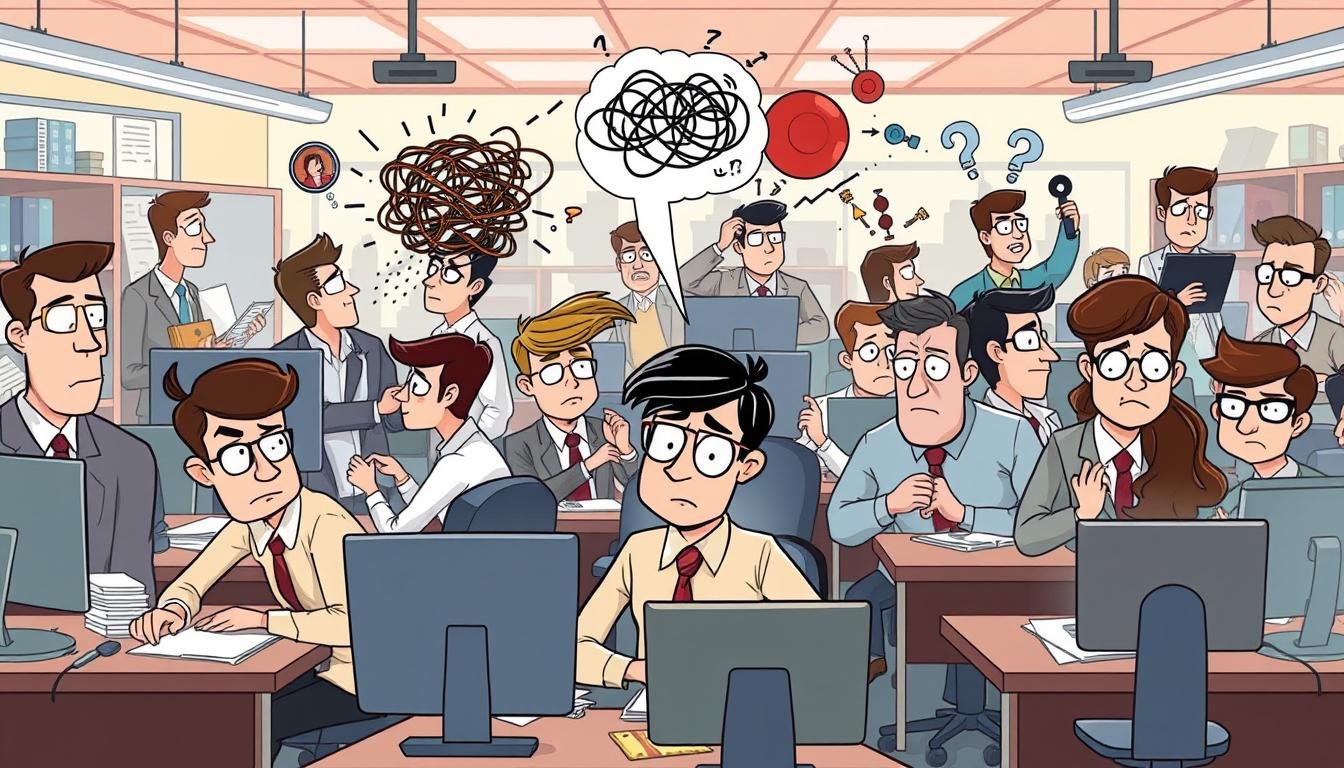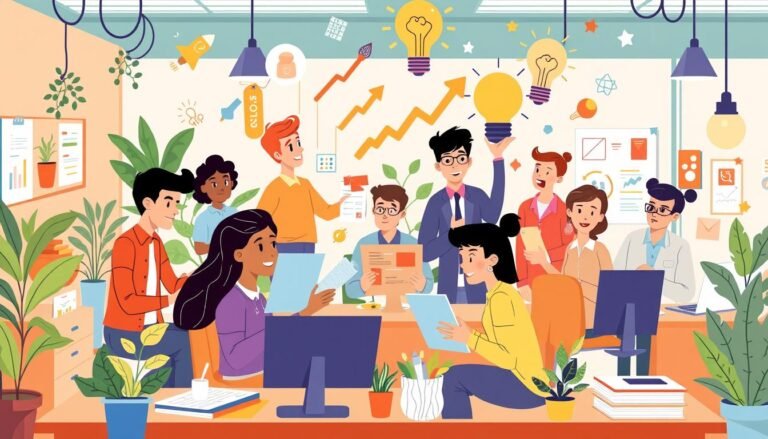Cognitive Load in the Workplace: How It Impacts Employee Performance
Is your workplace drowning in digital noise? Today’s fast-paced work environment is filled with endless information, tasks, and distractions. This digital storm is making cognitive load a big problem, affecting how well we work.
Cognitive load is the mental effort needed to handle information. It’s key to how well employees do their jobs. As workplaces change with technology, dealing with too much information becomes a major challenge.
A study from the University of North Carolina showed that too much digital communication makes workers less productive. This is especially true for those who rely a lot on technology. It shows why tackling cognitive load is important for keeping performance and employee happiness up.
The move to remote work has made things even harder. A study of 3,000 manager-employee relationships found more after-hours messages when working from home. This could make cognitive overload worse and mix up work and personal life.
Key Takeaways
- Cognitive load significantly impacts workplace productivity and performance
- Digital transformation has increased information processing demands on employees
- Remote work has intensified cognitive load challenges
- Multitasking and information overload lead to decreased productivity
- Managing cognitive load is crucial for employee well-being and organizational success
- Effective strategies are needed to reduce cognitive load in the workplace
Understanding Cognitive Load Theory
Cognitive Load Theory (CLT) was introduced by John Sweller in 1988. It looks at how our working memory handles information and affects learning. CLT builds on Baddeley and Hitch’s 1974 model, which separates working memory from long-term memory.
Definition and Origins
CLT focuses on our cognitive limits, especially in working memory. Studies reveal we can hold about five to nine new items in our working memory for 20 seconds. This limits how we learn and do tasks at work.
Types of Cognitive Load
CLT identifies three types of cognitive load:
- Intrinsic: The inherent difficulty of the content
- Extraneous: Distracting factors unrelated to the task
- Germane: Effort required to develop new cognitive processes
Relevance to Workplace Performance
Knowing CLT is key for better workplace performance. Research by Marzano, Gaddy, and Dean shows activating prior knowledge boosts achievement. Techniques like retrieval practice and worked examples also improve learning and task performance.
| Challenge | Impact on Cognitive Load | Potential Benefit |
|---|---|---|
| Interactive learning media | Increases task-irrelevant load | Can promote learning outcomes |
| Immersion | Raises cognitive demands | Enhances engagement |
| Disfluency | Slightly increases load | May benefit learning in some cases |
By using CLT, companies can create better training and work settings. This aligns with our cognitive abilities, improving employee performance and happiness.
The Digital Transformation of Employee Experience
The digital transformation is changing the workplace. Companies are now offering remote work, leading to more digital communication. This change affects how we handle work and manage our time in the digital world.
Digital Employee Experience (DEX) is key to better engagement and productivity. Gartner says using easy-to-use tech is vital. Microsoft Digital Employee Experience and ServiceNow are leading this change.
Artificial intelligence is crucial for DEX. It automates tasks, gives personalized advice, and helps with chatbots. This tech aims to make jobs more satisfying and productive in digital settings.
“The digital employee experience serves as a view of the business ecosystem from an individual worker’s perspective, providing logical people platforms and integration of enterprise systems and tools.”
Measuring DEX success includes looking at user experience, sentiment, and productivity. When done right, it boosts employee return, keeps workers longer, and improves business results. Companies are adjusting to post-COVID by changing how they work and focusing on mental tasks.
The future of work requires skills like design thinking, social smarts, and managing mental load. As we move forward, businesses must use technology wisely and create a culture that welcomes change to stay ahead.
Cognitive Load and Information Processing
Our brains handle information through working memory, which has limits. Knowing these limits helps us do better at work.
Working Memory Limitations
Working memory can usually process 5-9 pieces of information at a time. This limits how well we can handle complex tasks. Visual and auditory info use different channels, allowing for some multitasking.
Impact on Task Performance
When we have too much info, our task performance drops. Too much info can make us forget things because our memory gets full. To do better, we should cut down on unnecessary info and focus on what’s important.
Multitasking and Productivity
Many think multitasking boosts productivity, but it often doesn’t. Our brains have trouble switching between tasks, making us less efficient. For example, writing notes by hand helps us remember better than typing.
| Cognitive Load Type | Description | Impact on Performance |
|---|---|---|
| Intrinsic | Inherent difficulty of the task | Varies based on task complexity |
| Extraneous | Unnecessary mental effort | Reduces available attentional resources |
| Germane | Effort for learning and understanding | Enhances long-term memory storage |
Understanding cognitive load helps us create better work environments. This boosts how well we process information and increases productivity.
Cognitive Load in the Modern Workplace
The digital workplace has changed how we work, bringing new challenges. With more remote work, employees face a flood of digital messages. This leads to information overload, affecting how well they perform.
Studies show that too much information is the main reason training doesn’t stick. Sessions longer than 30 minutes can make workers feel confused. This happens when too much data overloads their working memory, making it hard to learn and apply new things.
Adults can usually hold about seven pieces of information in their working memory. But in today’s workplace, this limit is often exceeded. Workers deal with many tasks, platforms, and messages, leading to less productivity and more stress.
“The digital transformation of work has outpaced our ability to adapt. We’re drowning in information, yet starving for wisdom.”
To tackle this, companies are looking at ways to lessen cognitive load. They’re trying:
- Breaking down data into smaller, easier-to-handle pieces
- Organizing information in ways that feel familiar
- Removing unnecessary metadata
- Setting “do-not-disturb” modes on communication tools
- Customizing digital tools to cut down on visual clutter
By tackling cognitive load, companies can improve employee performance and well-being. This leads to better business results in our digital age.
| Factor | Impact on Cognitive Load | Mitigation Strategy |
|---|---|---|
| Digital Communication | High | Implement communication breaks |
| Information Overload | Very High | Use data filtering and prioritization |
| Multitasking | High | Encourage single-tasking periods |
| Lengthy Training Sessions | Moderate | Break into shorter, focused modules |
Measuring Cognitive Load: The New Frontier of People Analytics
People analytics is changing. Traditional ways to measure performance don’t cut it anymore. Now, we’re focusing on cognitive load. This change could really shake up how we see and improve business success.
Traditional KPIs vs. New Metrics
Old KPIs don’t quite fit today’s work world. New metrics are coming to the table. They aim to capture the subtleties of cognitive load:
- Mental effort ratings
- Task difficulty assessments
- Physiological measures (heart rate, pupil dilation)
Quantifying Cognitive Load: A Challenge
It’s tough to measure cognitive load. Researchers are trying different methods:
- Subjective self-reports
- Objective physiological data
- Behavioral observations
Each method has its own strengths and weaknesses. The goal is to find ways to measure mental workload accurately. Without getting in the way of work.
Business Impacts of Cognitive Load Measurement
Grasping cognitive load can change the game for businesses. Companies that get this right will see big benefits:
- Improved productivity
- Enhanced employee wellbeing
- Optimized work processes
- Better resource allocation
As we get better at measuring cognitive load, we open up new ways to boost success and happiness in the workplace.
The Connection Between Cognitive Load and Employee Well-being
Cognitive load is key to employee well-being. It affects mental health and stress at work. When workloads rise, our mental energy drops, leading to burnout and less job happiness.
Research links high cognitive demands to stress, harming both body and mind. Too much information can make it hard to handle stress. This worsens anxiety and depression symptoms.
In many fields, like medical education, high cognitive load hurts performance and learning. This is true in the workplace too. Overwhelming mental tasks can lower productivity and job happiness.
“Prolonged exposure to high cognitive workload may impair the ability to regulate stress, exacerbating stress-related symptoms.”
Organizations must focus on employee well-being by managing cognitive load. They should give enough breaks, streamline work, and support mental health.
| Cognitive Load Impact | Employee Well-being Effect |
|---|---|
| High information processing demands | Increased workplace stress |
| Constant multitasking | Mental fatigue and reduced job satisfaction |
| Limited working memory capacity | Difficulty in task completion and decision-making |
| Prolonged high cognitive workload | Risk of burnout and mental health issues |
Seeing the link between cognitive load and employee well-being helps companies make better work places. This benefits both employees and the company’s success.
Strategies to Reduce Cognitive Load in the Workplace
Cognitive overload affects nearly 50% of workers, making it hard for them to focus. Businesses are finding ways to make learning more efficient and manage information better.
Technological Solutions
Digital tools are key in reducing cognitive load. Supernormal, a free tool for Google Meet users, offers up to 20 meetings a month on its Starter plan. The Pro plan starts at $13 monthly. Task management apps like Todoist also offer free options, with Pro plans starting at $4 per month.
Organizational Approaches
Companies are trying new ways to improve learning. One study showed that adding simple questions to online training helps organize and apply knowledge. Another found that brief summaries in learning materials greatly improve retention and information transfer.
Individual Coping Mechanisms
Employees can use personal strategies to manage cognitive load. Time blocking helps focus without distractions. Knowing your energy levels boosts productivity. Delegating tasks also helps avoid cognitive overload.
| Strategy | Benefit |
|---|---|
| Microlearning | Breaks complex subjects into bite-sized lessons |
| Collaborative Learning | Leads to deeper processing under high cognitive load |
| Cognitive Aids | Offloads demands on working memory |
By using these strategies, organizations can greatly reduce cognitive load. This leads to better employee performance and well-being.
The Role of Artificial Intelligence in Managing Cognitive Load
Artificial intelligence is changing how we handle cognitive load at work. AI tools track digital messages, spot patterns, and warn when we’re overloaded. This helps avoid burnout and boosts productivity.
Machine learning is being used in many tools to lessen mental strain. For example, in healthcare, AI makes electronic health records easier for doctors to use. It helps sort through data, simplifies paperwork, and offers smart advice.
The effect of AI on managing cognitive load is big:
- 23% of workers often or always feel burned out.
- AI tools have cut employee turnover by 10% in call centers.
- AI coaches give instant feedback, leading to better habits.
In schools, AI makes learning fit each student’s level. It adjusts tasks to match their skills. This way, students learn more and enjoy it more.
As AI gets better, it will change work forever. It automates simple tasks and offers smart help. This makes work more efficient and less stressful.
Implications for Leadership and Management
Today’s fast-paced work environment demands leaders to manage their cognitive load well. They face many challenges like too much information, making many decisions, and multitasking. These can make it hard for leaders to think strategically and make good decisions.
Effective management strategies are key to managing cognitive load and boosting productivity. Companies should make work processes simpler, use supportive technologies, and create a culture that values mental health. This way, employees can work at their best without feeling overwhelmed.
Leaders can take several steps to fight cognitive overload. They can prioritize tasks, delegate well, and set clear boundaries. Using mindfulness and promoting self-care can also improve cognitive skills and lower stress. By using these strategies, companies can make their work environment more productive and fulfilling for everyone.
Source Links
- Council Post: Why Cognitive Load Could Be The Most Important Employee Experience Metric In The Next 10 Years
- Is Cognitive Overload Ruining Your Employee Training?
- Mastering Cognitive Load for Workplace Learning Success
- The importance of cognitive load theory
- Understanding Cognitive Load in Digital and Online Learning: a New Perspective on Extraneous Cognitive Load – Educational Psychology Review
- An introduction to cognitive load theory – THE EDUCATION HUB
- Enhancing the Digital Employee Experience: A Comprehensive Guide
- DEX: Navigating the Intersection of Technology & Work Life » eShare Blog
- Workforce Solutions Review: Creating a Sustainable Digital Employee Experience – Logical Design Solutions
- Cognitive Load Theory
- Optimizing Lectures From a Cognitive Load Perspective
- Strategies to Avoid Decision Paralysis (or Cognitive Overload) in the Modern Workplace — Datamura Solutions
- Understanding Cognitive Load Theory Is Essential for Effective Corporate IT Training – techstructional
- Cognitive load and cognitive offloading
- Frontiers | Measuring Cognitive Load: Are There More Valid Alternatives to Likert Rating Scales?
- Frontiers | Editorial: Recent Approaches for Assessing Cognitive Load From a Validity Perspective
- Predicting Cognitive Load and Operational Performance in a Simulated Marksmanship Task
- Frontiers | Well-Being as a Cognitive Load Reducing Agent: A Review of the Literature
- Understanding Cognitive Workload: What Is It and How Does It Affect Us? – iMotions
- Relationship Between Cognitive Load Theory, Intrinsic Motivation and Emotions in Healthcare Professions Education: A Perspective on the Missing Link
- Strategies for Managing Cognitive Overload
- Six Strategies You May Not Be Using To Reduce Cognitive Load
- Combat Unproductivity: 10 Tips for Managing Cognitive Load | Fellow
- How can artificial intelligence decrease cognitive and work burden for front line practitioners?
- How Can AI Help Students Reduce Cognitive Load at School?
- How Artificial Intelligence Is Preventing Cognitive Overload, Compassion Fatigue And Job Burnout
- Understanding the Causes of Cognitive Overload in Leaders and How to Combat it.
- Managing cognitive load optimises learning
- Academic Management in Uncertain Times: Shifting and Expanding the Focus of Cognitive Load Theory During COVID-19 Pandemic Education







